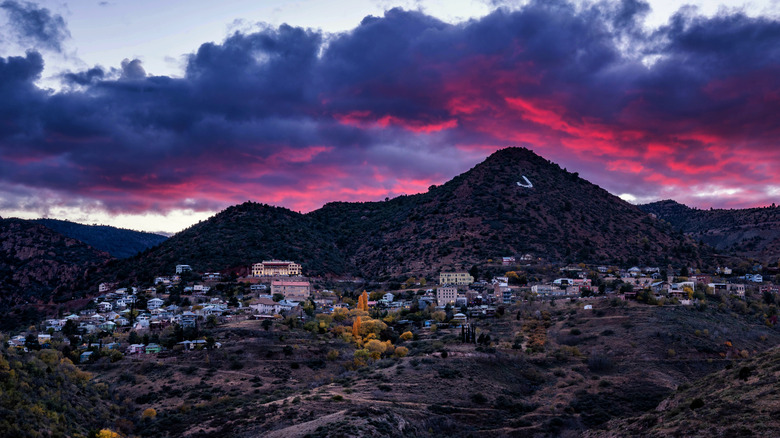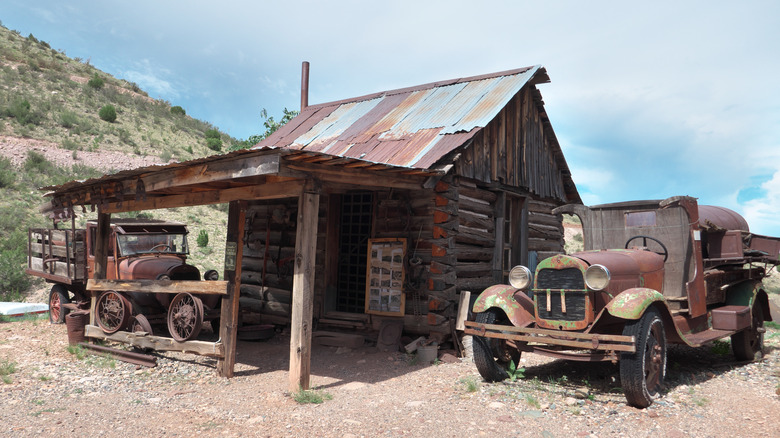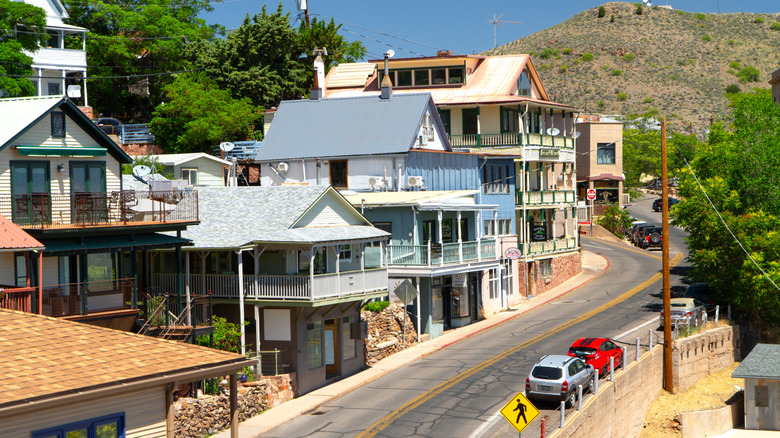A Historic Town In Central Arizona Was Renowned As The 'Wickedest Town In The West'
Why was Jerome, Arizona, known as the "Wickedest Town in the West"? For starters, the settlement was perched on Mingus Mountain, over 5,000 feet above sea level, and it was hard to reach before the invention of the automobile. Second, prospectors came here to mine veins of copper — and hopefully get rich. Men started making claims in 1875, and Jerome began its existence as a rough-and-tumble camp. In short, this was hard work done by ambitious people living in a remote location in the Arizona desert. By the turn of the century, more than 30 different nationalities lived in Jerome, adding ethnic tensions to the mix. In its heyday, Jerome had 15,000 residents, making it the fourth-largest town in the state; the mines extracted 40 million pounds of copper each year.
All of this would seem like a recipe for feuds and gun battles, and the row of saloons and opium dens probably didn't help. Jerome had its share of drama: Sheriff John William Hudgens had to use lethal force in several occasions. The "Chinese Massacre of 1897" was a violent attack against local immigrants that resulted in five deaths. Moonshiners set up shop in "Husbands' Alley," right through Prohibition. Meanwhile, Jerome endured several devastating fires. One of the last remaining mines closed in 1953, and the town emptied out, leaving only a handful of diehard stragglers.
But Jerome has swung back, and it has long left those wicked days behind. Today, Jerome is known for its eclectic dining scene, lively artists' community, and mix of restored buildings and intact ruins. You should absolutely add it to your scenic road trip to Arizona's most unforgettable views.
Jerome's unlikely return
When you climb the sloped streets of Jerome and gaze out at the spectacular views of the Verde Valley, it's hard to believe this vibrant community was once so desperate. Most residents left after the collapse of the local copper industry, leaving fewer than 100 residents behind. Life had never been easy here, given the mountain's 30-degree angles and arid climate. Yet even as neglected buildings caved in, Jerome never became a full-on ghost town. Paul & Jerry's Saloon, located in the middle of Main Street, has operated continuously since 1899, and it's now considered the oldest family-run saloon in Arizona.
In a surprising turn of events, Jerome became a counterculture enclave during the 1960s and 70s, thanks to an influx of hippies and artists. These folks were very different from the hardscrabble miners who had first settled Jerome, but they were drawn to the relative remoteness and vintage infrastructure, which they started to renovate into habitable homes. A new generation of entrepreneurs began to celebrate Jerome's Wild West past: The Gold King Mine and Ghost Town attraction is like a cross between a museum and a scrapyard, and the Jerome Historical Society operates its own Mine Museum, which has used period artifacts to tell the town's story since the 1950s. Like these 25 ghost towns around the U.S., Jerome has plenty of haunting old sights, including crumbled walls and age-old cars rusting in the Arizona sun, but visitors also benefit from the upscale Asylum Restaurant, Altai Leather Designs, and the Nellie Bly Kaleidoscopes and Art Glass, an enchanting art gallery named after the fearless female journalist (1864-1922).
Getting to Jerome and area attractions
By car, Jerome is almost exactly two hours from Sky Harbor International Airport in Phoenix. The route here is an eye-popping survey of desert geography, mostly taken along Route 17, and you'll pass Arizona's oddly experimental "city of the future" on your way here, which is absolutely worth a drop-in. Compared to Arizona's lower elevations, Jerome has a temperate desert climate, rarely reaching 100 degrees Fahrenheit in the summer and sometimes receiving light snow in the winter. Jerome has a robust dining and retail scene, and the Jerome Music & Arts Festival takes place every September.
Jerome has a handful of accommodations, which cost about $150 or more per night; you're better off staying at the bottom of Cleopatra Hill in Cottonwood, where there's a much wider range. But for history buffs and ghost hunters, there's the massive Grand Hotel in Jerome, which occupies a former hospital from 1927. This cheery building has a harrowing past, and many believe that spirits of medical patients still dwell here. It's also a lovely place to stay, with vintage decor and balconies in many of the rooms.
While you're in the area, you might consider a trip on the Verde Canyon Railroad in Cottonwood, just a 15-minute drive down from Jerome. This antique locomotive threads its way through the district's red-rock canyons, illustrating what visitors would have seen on their way here over a century ago. Jerome might have been "wicked" back in the day, but now it's a favorite Arizona getaway — and a window into America's past.


